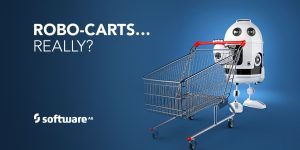Three ways IoT is transforming inventory management
‘Tis the season for returns; when holiday hangovers are traded in for New Year’s resolutions — and consumers set out on a gift-returning frenzy. For retailers, it is a complex time logistically and revenues can be lost. But it doesn’t have to be that way.
As shoppers hustle to ship or bring back items that don’t fit or they don’t like, there’s an opportunity for retailers to move that inventory quickly to another loyal customer. But without the ability to see returns or exchanges in real time, that inventory becomes a burden on the bottom line.
After employees and “store estate” (physical and online premises) inventory is arguably the most valuable resource a retailer has. Without it, the retailer cannot trade. In today’s omnichannel world, inventory is more valuable than ever, but it must be in the right place at the right time — or the business suffers.
The connectivity and real-time analytics inherent in IoT could be the game changer for retailers’ inventory woes.
Here are three ways I see this taking shape:
The digital shelf
During the holidays, popular inventory is the Superman of brick-and-mortar – leaving the shelf faster than a speeding bullet. Post-holiday this same inventory can stick to the shelf like molasses. This is one reason why retailers offer deep discounts in January.
With digital shelves, a sensor can be added that understands the level of inventory on the shelf, reading smart tags on the products. Another sensor could read passing foot traffic to determine whether the product placement is attracting enough passers-by.
With digital shelving, if inventory is low in a store yet, at the same time, these items are being shipped back, you can reroute the units to go directly where demand is high. Typically, inventory is shipped back to distribution, then processed and resent to stores in need. By cutting out the middleman and rerouting shipments, retailers avoid the extra time and costs associated with processing returns — and can get the product to customers faster.
RFID for real-time inventory
RFID chips can be placed on clothing, or even inside it, to give each garment an individual ID. RFID chips are cost effective and don’t require any power source (battery or electricity); companion technology (RFID readers) enables fast and accurate locating.
Along with other IoT-enabled technology — a combination of store-shelf sensors, smart displays, digital price tags and high-resolution cameras — retailers can see what is where. From the store shelf to the back stockroom, central warehouses and other stores, they can link these sets of inventory data for full visibility.
For example, G-Star Raw franchisee Denimwall is using garment-level RFID technology in order to track inventory movements across the supply chain and within the store itself. Being able to locate a specific style/color/size combination within the store in real time makes the promising and reliable fulfillment of online orders far more reliable.
Robo-carts
Robotic carts, guided by sensors and video cameras, are intended to let shoppers summon them using their smartphones and then dispatch them back to the storage area when they are finished. Employees can then concentrate on filling shelves or working at checkout, rather than rounding up carts throughout the store and in the parking lot — or further.
Connected to an inventory management system, robo-carts could determine highly accurate real-time inventory as customers move them around the store. This would ensure an accurate, up-to-the-minute view of what shelves need restocking and what products are selling fast — or which are being returned. Incorporating real-time analytics and process orchestration allows supply chain and merchandising processes to respond in real time and determine whether they need to apply a discount to items they want to get rid of.
This is a great IoT use case. Having the ability to connect robo-carts to existing systems to make the insights that the carts gain actionable is imperative, as is having a real-time response to what the cart finds. Smart retailers applying this technology will automatically respond via process orchestration, ensuring problems are eliminated and opportunities are benefited from. Sensors could transmit information to report planogram compliance to the head office to assist with a consistent shopping experience.
Customer movement patterns can be leveraged for merchandise planners to optimize layouts and understand the impact of promotional areas and make sure specific items are not returned or are bought out at a record pace. Sensor-equipped carts could form part of a smart store monitoring solution, advising when a “clean-up on aisle one” is needed. Or they could detect product theft before a perpetrator leaves the building.
Tackling the inventory challenge requires investment, but it can be attained quickly via real-time connectivity and sophisticated orchestration across different systems, including ERP, store inventory management, warehouse management and other inventory masters such as the inventory systems of suppliers.
Optimizing resources will allow you to distribute products — from ordering to pick-up and delivery — from any channel. This is truly maximizing return on resources.
All IoT Agenda network contributors are responsible for the content and accuracy of their posts. Opinions are of the writers and do not necessarily convey the thoughts of IoT Agenda.



